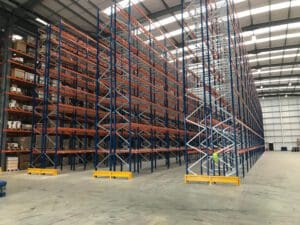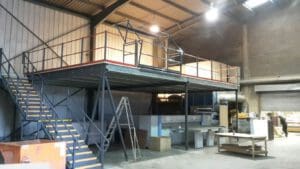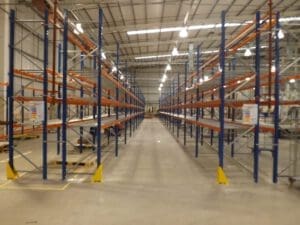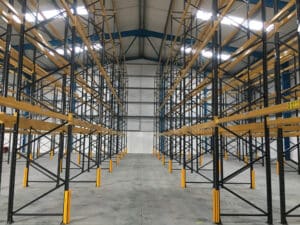
Advanced Handling & Storage Ltd
The Pallet Racking People

A warehouse is traditionally defined as a building in which to store bulk produce or goods for commercial purposes, however, over the last decade or two, we have seen the introduction of a number of processes, including automation, warehouse management systems and optimised space planning amongst others, which has helped to transform these spaces into an agile and flexible resource that can act as a true competitive advantage for a company when engineered correctly.
Some warehouse operations have kept up with the times, but it’s easy to get lost in the whirlwind of change that has engulfed the industry over the last few decades. Our latest blog offers 10 tips which can be used either in isolation – or combination – to help you get the most out of your existing warehouse operation, with the hope of developing your facility into an agile resource that is ready to face any number of challenges that lie ahead. Let’s take a look.
Geographical positioning
The geographical position of your warehouse can act as a key advantage, especially when you consider how far your logistics arm has to reach in order to deliver goods effectively.
Advanced Handling & Storage regularly work with our clients to model their physical distribution network to try and optimise costs and customer service objectives, particularly if you need to serve multiple locations across the country, e.g. north and south; ports; remote areas, etc.
A strategically-positioned warehouse facility and/or network of smaller storage depots can help to reduce travel-times, whilst enabling contractors to collect new orders and suppliers to deliver materials more effectively, too.
The strategic position of your warehouse can act as a competitive advantage

Automation
Automation focuses on the introduction of machines and robotic devices into a process, activity or place, and is becoming increasingly popular in modern-day warehouse setups.
When most people think of automation, they think of large-scale, automotive production lines, such as the Mini plant in Cowley, Oxfordshire. But mechanisation doesn’t have to be anywhere near as complex as this!
One simple way of introducing automation into your business is through a semi-automated system, such as a pallet shuttle. This system offers a perfect solution for those who are looking to maximise warehouse footprint whilst achieving maximum pallet capacity at a more affordable cost.
Mezzanine floors and multi-tier systems
A warehouse mezzanine floor can offer you a cost-effective and practical means of maximising the usable height of your warehouse.
It is also a cost-effective solution for adding additional bulk storage and is much cheaper than the alternatives, e.g. expanding your existing facility or moving to a new site entirely. What more, a mezzanine floor is also highly flexible in nature, and can be easily reconfigured over time to handle a changing product or order profile. A mezzanine floor can also be converted into a multi-tier system by installing additional levels or as part of a rack-supported structure, which can support various storage systems.
The system can also be customised to feature warehouse conveyors to enhance picking times and operational efficiency.
Running out of space? Make the most of your warehouse with a mezzanine floor.

Warehouse management systems
A fully integrated warehouse management system (WMS) can allow for the quick transmission of detailed information throughout your supplier network.
These systems can also help to reduce activity times, resulting in minimised costs and greater responsiveness overall.
Make sure you find a WMS that fits your operation, not the other way around! As having a WMS that fits your operation will enable you to build your processes around your customers and not your WMS.
A WMS system also offers you the ability to organise your product, meaning you can specify how much product you want to put into set boxes, further helping to minimise waste and optimise your process.
Inventory holding
Are you holding enough stock in your warehouse? In the age of e-commerce and the ‘I want it now’ culture, it’s important that you hold enough stock to fulfil customer demand, otherwise, you could be missing out on orders.
Your best option is to create a replenishment strategy by identifying how much stock you need to store at the pick face.
There is a fine art to balancing your stock levels. Too much, and you risk holding excess stock that may never shift. Too little, and you run the risk of creating frustration amongst your customers when they can’t find the right size to order. Modern technologies, such as warehouse management systems combined with flexible storage systems can help to identify popular SKUs, making sure you don’t run out!
Postponement strategy
Postponement is a business strategy in supply chain management, where a manufacturer produces a generic product, which can then be customised at a later stage before being transported to the customer. This allows the company to minimise risk by delaying further investment in a product or service until the last possible moment.
A good example of a company that uses this strategy is the computer company, Dell. They have a popular online store where you can choose to build a computer to your exact specification. Dell keeps all of the generic computer parts on-site and then build the computers to order; offering their customers’ a truly bespoke service.
This strategy isn’t applicable to all types of operation, but it may be useful if you store and assemble components and parts on-site. You just need to consider how best to integrate this into your process flow, which is something we can help with.

Versatile materials handling equipment
Flexible MHE is vital to a modern-day warehouse operation. If your staff don’t have the right equipment to work with then this can slow them down considerably, reducing productivity and, ultimately, profit.
A good example of a flexible MHE system is a man up truck, typically used in a very narrow aisle (VNA) racking setup. Systems such as these enable high turnaround capacity and order picking, in turn, enhancing productivity and picking efficiency.
Other systems that can add versatility into your warehouse setup include stacker trucks, materials lifts and pallet pump trucks. Some of these options are very affordable and can be used to enhance the efficiency of put-away, replenishment and order picking.
Shared warehousing
The concept of ‘shared warehousing’ is similar to the model of ‘co-opetition’; a good example being the shared partnership between automotive companies, Citroën, Peugeot and Toyota, who share overheads and manufacturing costs regarding the production of their C1, 107 and Aygo models respectively.
In a shared warehousing scenario, the overheads, e.g. maintenance and operating costs will be spread across the different companies that occupy the space. The owner of the facility may also be able to provide additional space, fulfilment and on-site security services.
A shared warehouse setup could allow you to enjoy a flexible warehousing solution, with storage space being either increased or decreased depending on the demand for your products. It is something that is definitely worth considering if you are looking to minimise overheads moving forward, and it may also allow you to get closer to your customers, depending on its geographical position.
Duality
Duality and the dual supply chain model is a system that incorporates flexibility and rapid responsiveness into a logistics operation.
A dual supply chain allows you to segregate processes to focus on different customer / business requirements for different product types, moving you away from the ‘one-size-fits-all’ policy.
Duality is most typically used in the fashion industry, a good example being where core products with consistent sales are operated using ‘lean’ methodology, whereas seasonal items are put through an agile process.
Duality may not be suitable for all operations, however, depending on the type of products you manufacture it could be put to good effect within your own operation, allowing you to incorporate lean processes and economies of scale.

Get in Touch with Advanced Handling & Storage
So, there you have it, our top tips to help you build a warehouse that is agile, flexible, and ready to meet the challenges that lie ahead. All of these tips are presented as suggestions, and if you are interested in incorporating any of the above into your warehouse setup we would be more than happy to help. Get in touch and speak to our experts on 0800 345 7088 or send an email to [email protected] to find out more.
Make sure you follow #TeamAdvanced on Social media for all our latest news and offers.
Like us on Facebook
Follow us on Twitter
Connect with us on LinkedIn
Subscribe to Our YouTube channel
Follow us on GooglePlus
Read our other blogs on Medium
Follow us on Instagram